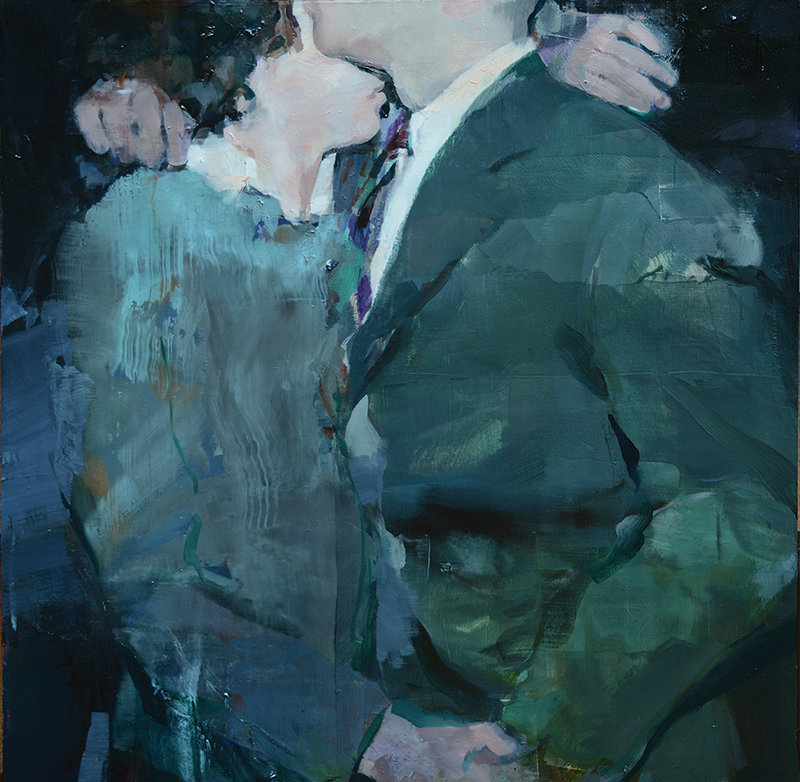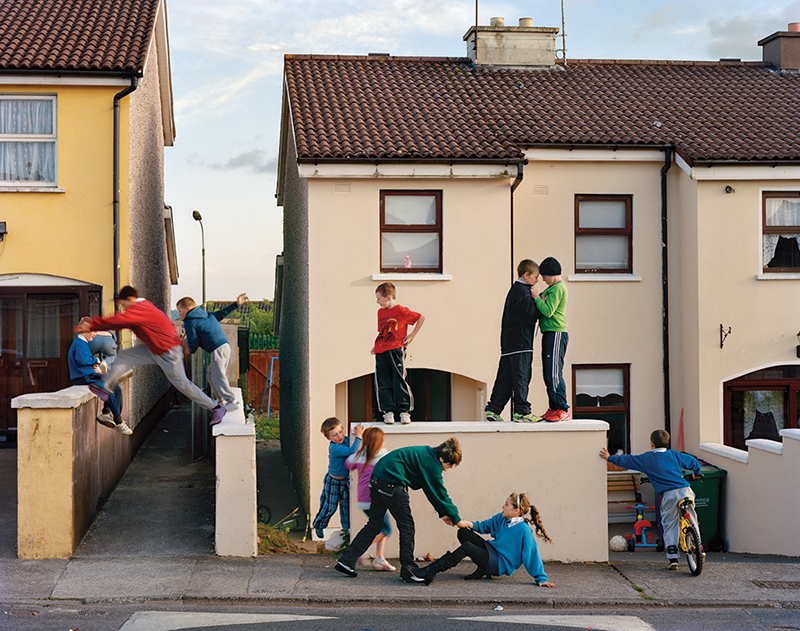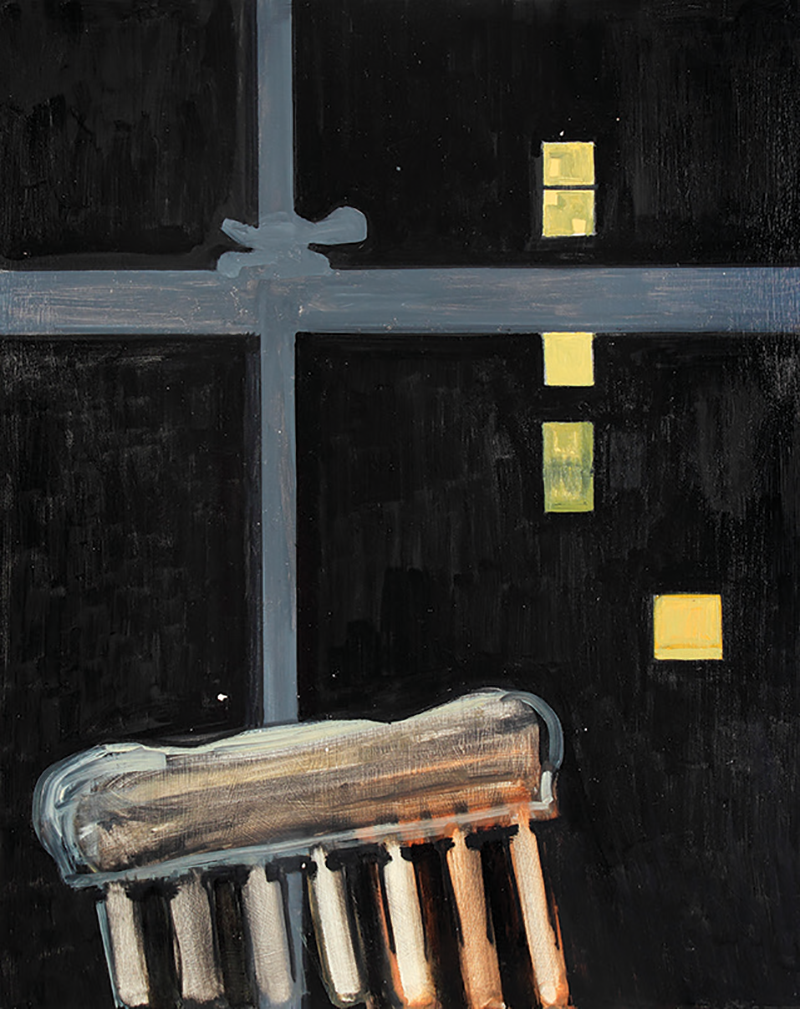
Lovers and Time, by Alex Kanevsky © The artist. Courtesy Dolby Chadwick Gallery, San Francisco
Danielle McLaughlin’s debut novel, The Art of Falling (Random House, $28), recounts a tumultuous season in the life of an art curator, Nessa McCormack, in Cork, Ireland. The McCormack family—Nessa; her architect husband, Philip; and their sixteen-year-old daughter, Jennifer—is attempting to find its footing in the wake of Philip’s philandering (an affair with the mother of Jennifer’s former best friend), while Nessa prepares to mount a major exhibition of the work of the late (fictional) sculptor Robert Locke. For months, she has been interviewing Locke’s elderly widow and unmarried daughter. Central to the show is a piece known as the Chalk Sculpture, a rendition of a pregnant woman that has become a pilgrimage site for women with fertility problems. Nessa gives a lecture about Locke’s work at her gallery, after which an eccentric woman named Melanie Doerr approaches her and claims co-authorship of the sculpture. This is the first of many, ever more unsettling encounters with Doerr—“I should not have to spell it out. That statue is mine”—whose zeal is matched by her lack of social boundaries.
As if this were not enough, a chance encounter with a former roommate leads Nessa to reestablish contact with Stuart Harkin, a sometime lover of hers from that period, and Stuart’s now grown son, Luke. Luke’s mother, who had been Nessa’s best friend, committed suicide when Luke was just three years old. The historical complications of these relationships return in force when Luke’s great-aunt gives him his mother’s letters and diaries from that time: the clandestine affair between Nessa and Stuart comes to light, and the revelations undermine Nessa’s moral superiority as the wronged wife. Luke, enraged by his discoveries, allies himself with Melanie Doerr, keen to champion her cause, and befriends Nessa’s daughter, bringing the various strands of distress home to the McCormacks.
McLaughlin turned to fiction after a career as a lawyer, and she is the author of one earlier book, the exceptional story collection Dinosaurs on Other Planets. In The Art of Falling, she tackles her complex plot with the precision of a master technician: conflicts escalate, and with them suspense, in a well-paced and meticulously conceived narrative. Even as the novel carefully braids its many strands and pulls them toward a dramatic climax—I could picture the actual shots in the high-end miniseries this book would make—McLaughlin raises thoughtful questions about responsibility and truthfulness in intimate relationships, about artistic authorship and ownership, and about the roles of gender and of generations in artistic production. While Melanie Doerr demands credit for her part in Locke’s work, Locke’s wife, Eleanor—when Nessa realizes that she, too, made art—demurs: “I was no artist. I made things for my own amusement. . . . Robert was the artist, and one artist in any family is quite enough, thank you.”
Through minor observations (Nessa notes that her boss never sucks in his belly, “not even when he was being photographed, [he] never felt the slightest need to make himself smaller”) and passing details (Luke, having dropped out of college, has become a street photographer and plans to photograph the same street at the same time every day for a hundred days), McLaughlin captures the textured tapestries of these compellingly believable lives, from the expensive cars parked outside Jennifer’s private school to the needling discomfort of recalling, in precise detail, the transgressions of decades past. At the same time, The Art of Falling—a title whose layered cleverness only eventually becomes clear—is perhaps a mite tidy, its strands rather too perfectly braided. The elaborate plot, in the tradition of centuries, relies on discovered documents and artifacts and on their contemporary counterpart, social media. The climax, inevitable, also feels contrived. And the relatively happy ending (complete with a note in a minor key) feels ideal for film. The messiness of life is here conveyed but also carefully contained—a tight hand with form indeed makes an art of the fall.
A Lie Someone Told You About Yourself (Houghton Mifflin Harcourt, $24) is Peter Ho Davies’s third novel, and it, too, creates controlled art out of life’s messy pain, although in a very different way. Davies is less interested in the bourgeois fabric of life—where McLaughlin is like Ibsen, whose plays are cluttered with objects, Davies is closer to Chekhov, whose characters act on a near-empty stage. McLaughlin’s formal control manifests chiefly in pacing and plot, whereas Davies is preoccupied with tone and verbal restraint: his protagonists—a father, mother, and son—remain nameless. There is nothing superfluous in these pages, and yet Davies, whose characters’ humor carries the reader through considerable agony, allows cheerfully for life’s banality: “Piles of plastic drift around the living room like the Great Pacific Garbage Patch”; the family will traverse the “Age of Dinosaurs . . . also known as the Age of Disney,” the “Age of Star Wars,” the “Age of Harry Potter,” the “Age of Speed,” the “Age of Aquariums,” and the “Age of Coming of Age.”
It would be easy, under the sway of this mild and familiar parental wit, to underestimate the ambition of the book, both formally and emotionally. Like Akhil Sharma’s remarkable Family Life, A Lie Someone Told You About Yourself presents the writer, and the reader, with an unusual challenge: its tragedy takes place in its opening pages. The parents have been forced, by uncertain but potentially parlous fetal test results, to abort their first pregnancy. The entire novel is, in some way, an account of the aftermath of this event, for the boy would not exist were it not for the loss of the unborn girl. “The pregnancy is a vigil”: “They don’t discuss names. At a dinner party when a friend asks why she’s not drinking, his wife says, If I told you, I’d have to kill you.” Above each anxiety—from the very first, an alarming C-section that takes the infant boy to the NICU—hovers the burden of the lost child, a sense of potential doom.
When the boy first goes to pre-school, his teacher raises issues:
Their anxiety pools. Perhaps we should get him evaluated, they whisper. They don’t say tested; they don’t say what for.
They take him to the pediatrician, who suggests a specialist.
They take him to a specialist, who suggests physical therapy.
They take him to a physical therapist, who says he’s a year to eighteen months behind developmentally. “He’s three,” the father says. “You’re telling me he’s half his life behind?” It feels like something has been stolen.
There’s the humor; there’s the pain, and behind it, greater pain. Something has indeed been stolen, of course—not just innocence, but another child’s life.
Davies handles time with particular care too, in the manner of Thomas Mann in The Magic Mountain—that’s to say, as we live it, accelerating with familiarity. The early days and months take longer to recount than entire years, later on. Even in sentences pared down to the essentials, Davies’s nameless and hence faceless characters (in the way that McLaughlin’s powerful Chalk Sculpture is faceless) shift the quotidian (not just toys and childhood fads, but intimacy, sex, and masturbation) into the universal register of myth. This is Life, the characters’ namelessness implies: countless parents will pass along this path.
This, too, is Art: the father is a professor of creative writing (as is Davies) who assures his students that
One of the gifts of fiction . . . is the cover it provides. A story can be 1% true and 99% made up, or 99% true and 1% made up, and the reader won’t know the difference, the writer doesn’t have to declare. It means he can tell the truth and take the Fifth simultaneously.
The novel flirts at various moments with this suggestion of autofiction; and, in a different way than McLaughlin does, with questions of artistic responsibility:
He used to think he wrote for immortality. Once he had his son, he worried he’d lose that desire . . . but now it occurs to him his son is the physical embodiment of posterity. The posterity whose judgment he yearns for. And cowers from.
This is how you tell him, he tells himself. How you tell him you love him. How you tell him you killed his sister. How you tell him he wouldn’t be here if you hadn’t.

“Russell Heights, Cobh, County Cork, Ireland,” by Doug DuBois, from My Last Day at Seventeen, published by Aperture © The artist. Courtesy Sasha Wolf Projects, New York City
A Lie Someone Told You About Yourself is a novel about the comedy and travails of parenting a “twice exceptional” child that earns its place on the shelf alongside the frank and sometimes acerbic memoirs of Rachel Cusk and Anne Enright. But it is simultaneously a novel about abortion, the opposite of parenting. While the mother goes into therapy, the father, to whose reflections we are privy, enlists as a volunteer escort at an abortion clinic: “typically male, he understands. This desire to fix something, to protect someone.” Shame and guilt suffuse the narrative—societally imposed emotions which the father seeks to explore.
Later, he will understand that he’s not been at the clinic to do good, or even to gather material, so much as to find absolution . . . Later still, he will understand that all these feelings—his, his wife’s—just won’t fit between the lines, between the sides. In the political box. He doesn’t want to argue about those feelings, to defend them or justify them, he just wants to be left alone to feel them.
Davies struggles to evoke the ineffable, to render in careful, simple prose and with sustaining humor the complex well of feelings, so many of them painful, that his characters experience. It is a task at which it is perhaps impossible fully to succeed, but he comes movingly close.

Chair, Night Window, by Lois Dodd © The artist. Courtesy Alexandre Gallery, New York City
Nadia Owusu’s memoir Aftershocks (Simon and Schuster, $26) endeavors, similarly, to give voice to experiences that challenge articulation. As its title suggests, the book’s central metaphor is seismic—a linking (more or less successful) of earthquakes and their terminology to more interior forms of upheaval. At the book’s core is an episode that occurred when Owusu was twenty-eight years old, in which she confined herself to a blue rocking chair that she’d dragged off the street into her New York apartment:
For seven days, I did not get out of the blue chair except to sleep on the floor and piss and shit and eat bran flakes, cans of tuna, hunks of dry baguette, and slightly moldy cheddar cheese I forced down with lukewarm tap water.
This stretch of incipient madness (the memoir is dedicated in part to “mad black women everywhere”) proves the occasion for Owusu to examine the abiding questions of her fractured and difficult upbringing.
The daughter of an Armenian-American mother and a Ghanaian father who worked for the United Nations, Owusu had a peripatetic childhood. Her mother abandoned the family when Owusu and her younger sister, Yasmeen, were small; initially, the girls lived in the U.K. with their father’s sister, Harriet, before rejoining their father and his new Tanzanian wife, Anabel. Nadia and Yasmeen were joined by a younger half-brother, Kwame, and the family moved between Dar es Salaam, Addis Ababa, Kampala, and Rome. Owusu briefly attended boarding school in the U.K., and spent time with her father’s family in Ghana. (Her mother had returned to the United States, where she married a Somali man and had two more daughters, whom Owusu rarely saw.) Owusu and her sister might be called Afropolitan, as the writer Taiye Selasi terms it; they are global children, cosmopolitanism incarnate. Though of an earlier generation, I am myself the child of a French pied-noir father and an anglophone Canadian mother, raised in Australia, Canada, and the States, with time spent in France, and I have particular interest in and compassion for Owusu’s cultural complexity, for the code-switcher’s attentiveness to what’s necessary for survival. I was raised to believe that this hybrid existence was the world’s future, a positive and hopeful development; but that was long before the current resurgence of bitter tribalisms, nationalisms, and authoritarian governments across the globe.
The gamut of Owusu’s youthful experiences—from her survivor’s instinct to be considered American rather than African at her British boarding school, and her subsequent cruelty to the only other black girl in her dorm, to her visit with her father to the stool house of the Oyoko clan, to which her grandfather belonged, outside Kumasi, Ghana—make for compelling reading, interspersed as they are with elucidating histories of the countries with which she is affiliated or in which her family made their home. But this nomadic worldliness, privileged but also uneasy, is not the ultimate focus of Owusu’s reflection. Rather, it serves as the background to an abiding reality of isolation and trauma.
When Owusu was almost fourteen, her father died in Rome—of cancer, she believed, until years later when her stepmother told her that in fact it had been AIDS. This revelation is partly responsible for her retreat to the blue chair. Upon their father’s death, Nadia and Yasmeen’s mother refused to take them in, and they remained with their stepmother, with whom Owusu had a particularly difficult relationship. As a teenager, she was socially wild, and she was sexually assaulted, more than once. By the time she was an undergraduate at Pace University in New York, she was working two jobs to stay afloat. Not only did Owusu face the challenge of having no national or even physical home to return to; she found herself, from a perilously early age, without emotional support from her family.
In this sense, the memoir is triumphant: the survivor’s account of a thoughtful, passionate young writer grappling with life’s demons—with familial neglect and the rage of unmet dependency; with sexual assault and racism, both passive and active; and with the more general traumas of repeated cultural displacement. At the end of her week in the blue chair, Owusu, who had always idolized her father, makes peace at last with her two mothers, having recognized “how little thought I gave to my mothers’ desires and interior lives.” She performs a sacred ritual to honor all who have supported her over the years.
But this sense of hard-won redemption doesn’t feel entirely convincing, given the tenor and form of the memoir. Aftershocks is written in an elaborately fragmented manner, looping and uneven, held together by the metaphors of the earthquake and the chair. But unlike the McLaughlin and Davies novels, Owusu’s memoir is affecting despite, rather than because of, its structure. In a prefatory author’s note, Owusu explains, “I write toward truth, but my memory is prone to bouts of imagination”—even the memoir’s factual ground remains unsteady. At times the book feels more a howl of agony intended to command compassion from a distance than a work of art created to evoke an emotional experience in the reader. This is perhaps more generally a risk of memoir than of fiction, but the difference arises, too, from the artist’s control of narrative form.






































































































